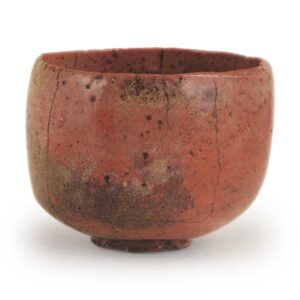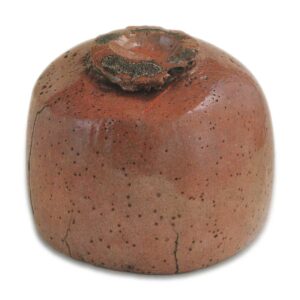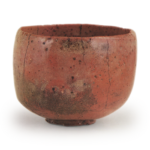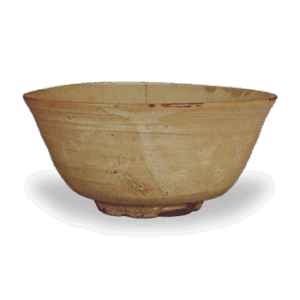

Height: 9.7 – 10.0 cm
Diameter: 11.5 – 11.7 cm
Outer diameter of foot: 5.4 – 5.7 cm
Height of foot: 0.6 cm
This tea bowl is one of the five, seven or ten masterpieces that Koetsu made, and is referred to as a “five-type, seven-type, ten-work” tea bowl. Therefore, it can be said that it was famous from an early stage. It is said that the name “Bishamon-do” was given to this tea bowl because it was said to have been presented by Koetsu to the Bishamon-do shrine at the Monzeki temple in Yamashina, Kyoto.
The rim is slightly inwardly sloping, so-called “kakeguchi”, and part of it is sharpened horizontally. The body has a relatively gentle, rounded surface, and one side of the waist also has a gentle, rounded surface similar to the body side, which continues to the foot ring. However, the other side has a chamfered shape that shows the marks of sharp tools, and it has a varied shape similar to the rim.
The footrim, which is an irregular polygon, also shows many traces of the tooling, but in some places the footrim is left as it was originally, without any tooling. Furthermore, the footrim is uneven, with the lower part shaped like a clam shell and the higher part shaped like a half-moon. The fact that the foot ring is slightly low and the shape is irregular polygon, which is close to a circle, is similar to the style of Koetsu’s tea bowl with the “Fuji” mark. Also, the fact that the back of the foot ring has the appearance of a go-stone container and the style of the rim being sharply cut reminds us of the tea bowl with the “Amagumo” mark. From these points, it can be said that this tea bowl shows a style that is a compromise between the Fujiyama and Amagumo bowls.
The body is thinly made, and both the inside and outside are covered in a beautiful red glaze with a strong sheen, but the color is closer to a brilliant red than to a true red. On top of this, a white glaze has been applied from the rim to the inside and outside, but some of the white has turned blue-grey, and some has turned light grey, etc., resulting in a glaze with a rich variety of tones, and this is particularly strong on the inside.
It is said that Koetsu often commissioned the firing of his tea bowls to the Raku potter Doi. From the time of Raku Do’iri, the firing temperature of Raku ware increased, resulting in a luster in the glaze and a more brilliant appearance. The glaze on this tea bowl is a color tone often seen on Do’iri’s tea bowls, and the crackle that appears from the rim to the center of the body is due to the high firing temperature, so it is thought that this tea bowl was fired with the help of Do’in.
It was received by Koyasan Kokan from the Bishamon-do temple, and later passed into the hands of Kawai Jūemon, and then into the possession of the Kōnoike family of Osaka, where it remained until recently.








